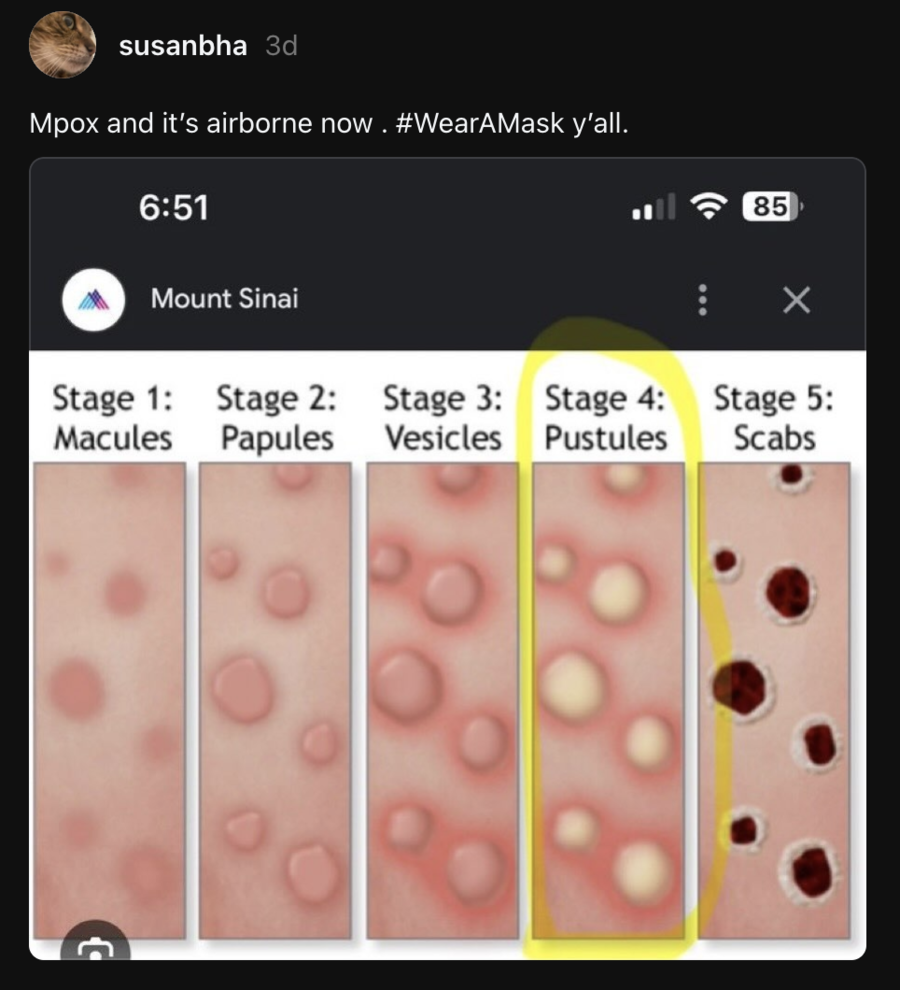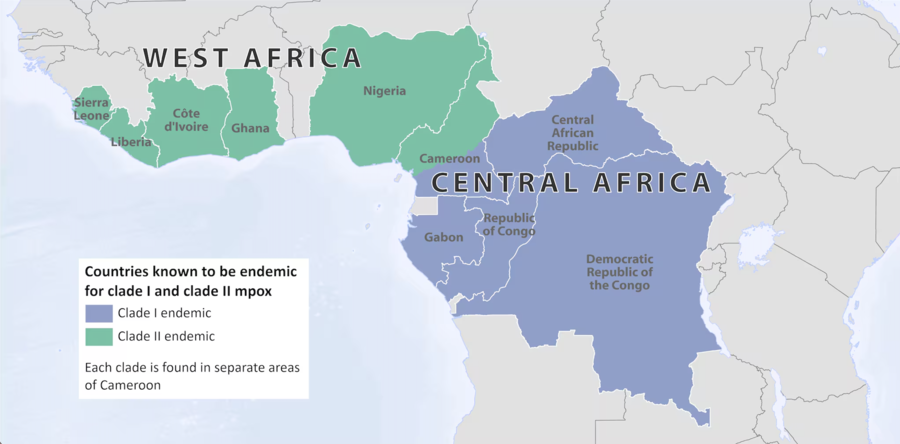
Is the monkeypox virus known to spread through airborne transmission, as suggested by a post on Instagram Threads? No, that's not true: Global health agencies agree that the primary way the virus is spread is through close or direct contact between an uninfected and infected person's body fluids, lesions or saliva, plus contaminated clothing or bedding. The U.S. Department of Health and Human Services notes that the "risk to the general public in the United States" of monkeypox is "very low."
A version of the claim appeared in a post on Instagram Threads on August 17, 2024 (archived here), which suggested that mpox -- another name for monkeypox -- was airborne. A caption with the post read:
Mpox and it's airborne now . #WearAMask y'all.
Here is how the post appeared at the time of writing:
(Source: Instagram threads screenshot taken Tue Aug. 20 1:48:37 UTC 2024)
The post was shared after the World Health Organization (WHO) determined (archived here) on August 14, 2024, that an upsurge in monkeypox cases across some African countries "constituted a public health emergency of international concern."
What is monkeypox virus?
Mpox -- the World Health Organization's nomenclature for what is commonly known as monkeypox (archived here) -- is a viral disease caused by a species of monkeypox virus, MPXV. The Centers for Disease Control and Prevention (CDC) describes (archived here) the condition as belonging to the same family as smallpox. Infection typically results in a rash undergoing several stages, including scabs, before healing.
MPXV can spread between animals and people, as well as between people, and is regularly found in parts of Central and West Africa.
What is airborne transmission?
Following a 2022 outbreak of pox, some researchers suggested that the virus' uptick in cases could be explained if it spread through airborne transmission. However, at the time of writing, health officials agree that MPXV is not known to spread through airborne transmission.
It's possible that the virus can spread through respiratory droplets, such as when a person coughs or sneezes, but viral particles are not known to linger or travel long distances, which is what respiratory transmission is. There are important differences between airborne transmission and transmission via respiratory secretions, according to the CDC (archived here).
Airborne transmission occurs when respiratory droplets aerosolize and linger in the air for some time. Droplets can be dispersed and suspended (archived here) in the air when an infected person coughs or sneezes. Aerosolized droplets can float and travel in air flows, infecting people who inhale them, as with SARS-CoV-2, according to a 2021 study published in the journal Science (archived here).
In contrast, the CDC writes that monkeypox may be found in droplets like saliva or respiratory secretions, which drop out of the air quickly.
Not known to spread via airborne transmission between humans
The CDC reported (archived here) at the time of writing that MPXV is "not known to linger in the air and is not transmitted during short periods of shared airspace." In other words, airborne transmission of mpox has not been reported.
The National Institute of Allergy and Infectious Diseases writes (archived here) that human-to-human transmission of MPXV occurs through direct contact (archived here) with body fluids, lesions, prolonged face-to-face contact and indirect contact with contaminated clothing or bedding. This can occur through skin-to-skin, mouth-to-mouth or mouth-to-skin contact and, in some cases, through face-to-face contact that can generate infectious respiratory particles, noted WHO (archived here).
Direct contact can happen during intimate contact in the following ways, according to WHO (archived here):
face-to-face (talking or breathing)
skin-to-skin (touching or vaginal/anal sex)
mouth-to-mouth (kissing)
mouth-to-skin contact (oral sex or kissing the skin)
respiratory droplets or short-range aerosols from prolonged close contact.
MPXV can also be spread through (archived here) direct contact with infected animals, typically rodents, and contaminated materials.
International concern following an uptick in cases since 2022
Mpox is endemic to West and Central Africa, but in 2022, WHO public health officials began tracking reports of infection in countries where it is not endemic, such as Europe and North America.
MPXV variants are called clades, or groups of organisms thought to have evolved from a common ancestor. According to the CDC, there are two types of MPXC: clade I and clade II.
(Source: CDC)
Clade I is endemic to Central Africa and associated with more severe illness, killing up to one in 10 people who get sick.
Clade II is believed to be the cause of the 2022 outbreak. Endemic to Western Africa, clade II infections are less severe, and 99.9 percent of those infected will survive. Within clade II are two subclades (archived here), clade IIa (low mortality) and clade llb (currently spreading globally by human transmission).
Both clades are spread through direct contact (intimate or sexual).
Some research suggests possibility of MPXV spread through airborne transmission
An article (archived here) published in the Canadian Medical Association Journal in 2022 suggested that although monkeypox is not considered an airborne transmission, it's unknown whether smaller viral particles known as aerosols can linger in the air for longer periods. It may be possible for monkeypox virus to become aerosolized. Still, airborne transmission does not appear to be the primary transmission mode.
Oxford researchers also wrote in The Lancet Microbe (archived here) in 2022 that MPXV can be shed into the surrounding environment by infected people and can remain infectious on surfaces for weeks. Virus DNA was found in some air samples, particularly after bed linen was changed, which suggests (archived here) "that viral particles, probably in shed skin particles, can become suspended in the air when bed sheets are changed."
Similarly, a 2023 study (archived here) published in The Lancet Microbe noted that modern outbreaks have sparked debates "regarding the roles of other possible transmission modes of MPXV, such as the airborne route."
An article published in The Lancet Respiratory Medicine in 2022 (archived here) concluded that the role of respiratory infection is not fully understood, and is an area of current research given the upsurge in cases.
Health officials recommend precautionary measures to avoid infection
The CDC (archived here) advises people to avoid close skin-to-skin contact with a person or animal with a rash that looks like mpox. Specific individuals should also get vaccinated (archived here).
Diagnosis of mpox typically requires detection of viral DNA through polymerase chain reaction (PCR) testing in the lab is preferred. Treatment involves treating the rash and managing pain.
As of August 14, 2024, the U.S. Department of Health and Human Services (archived here) notes that the "risk to the general public in the United States" is "very low." At this time, there is no recommendation for people to wear masks to avoid infection.
Other Lead Stories fact checks on claims related to health issues are here.

















